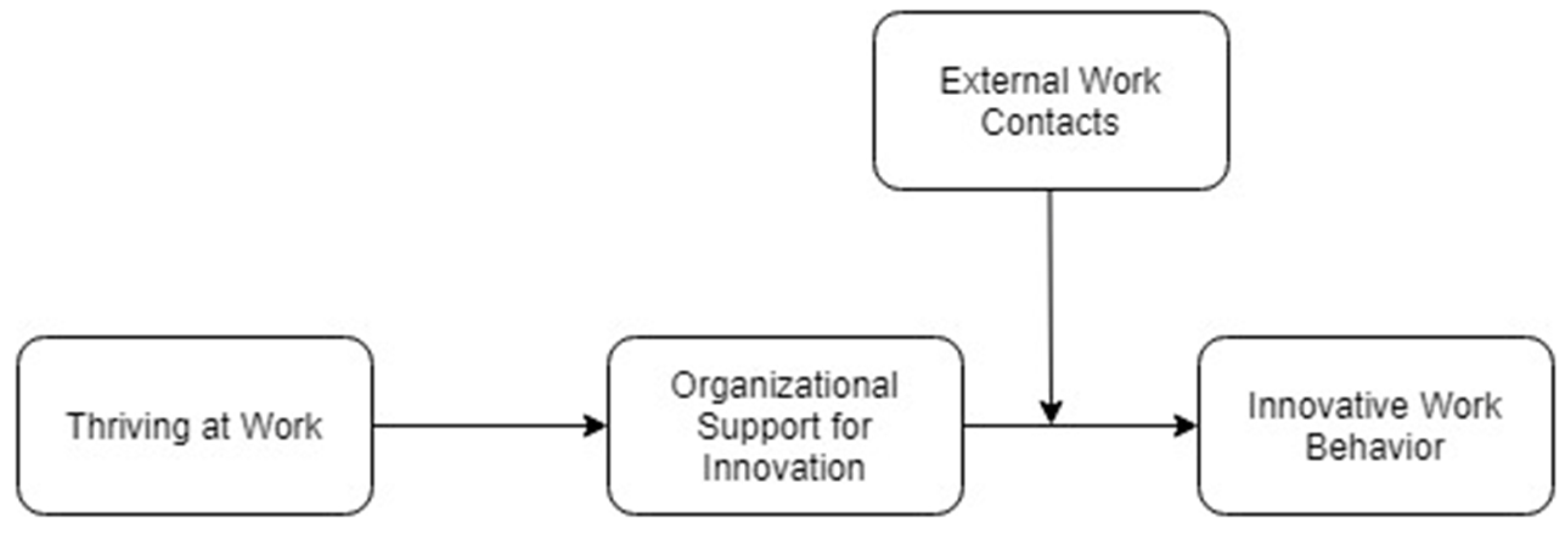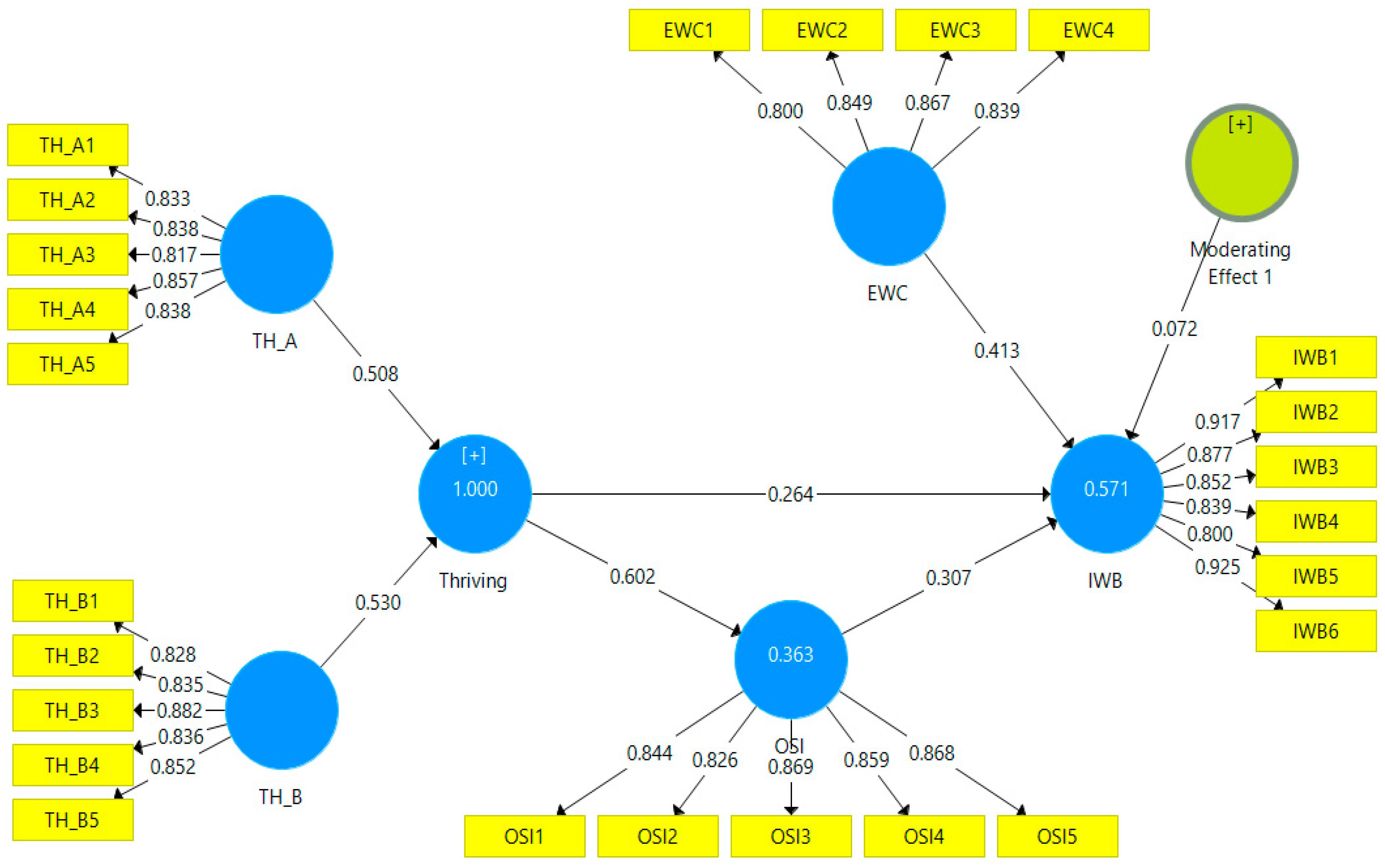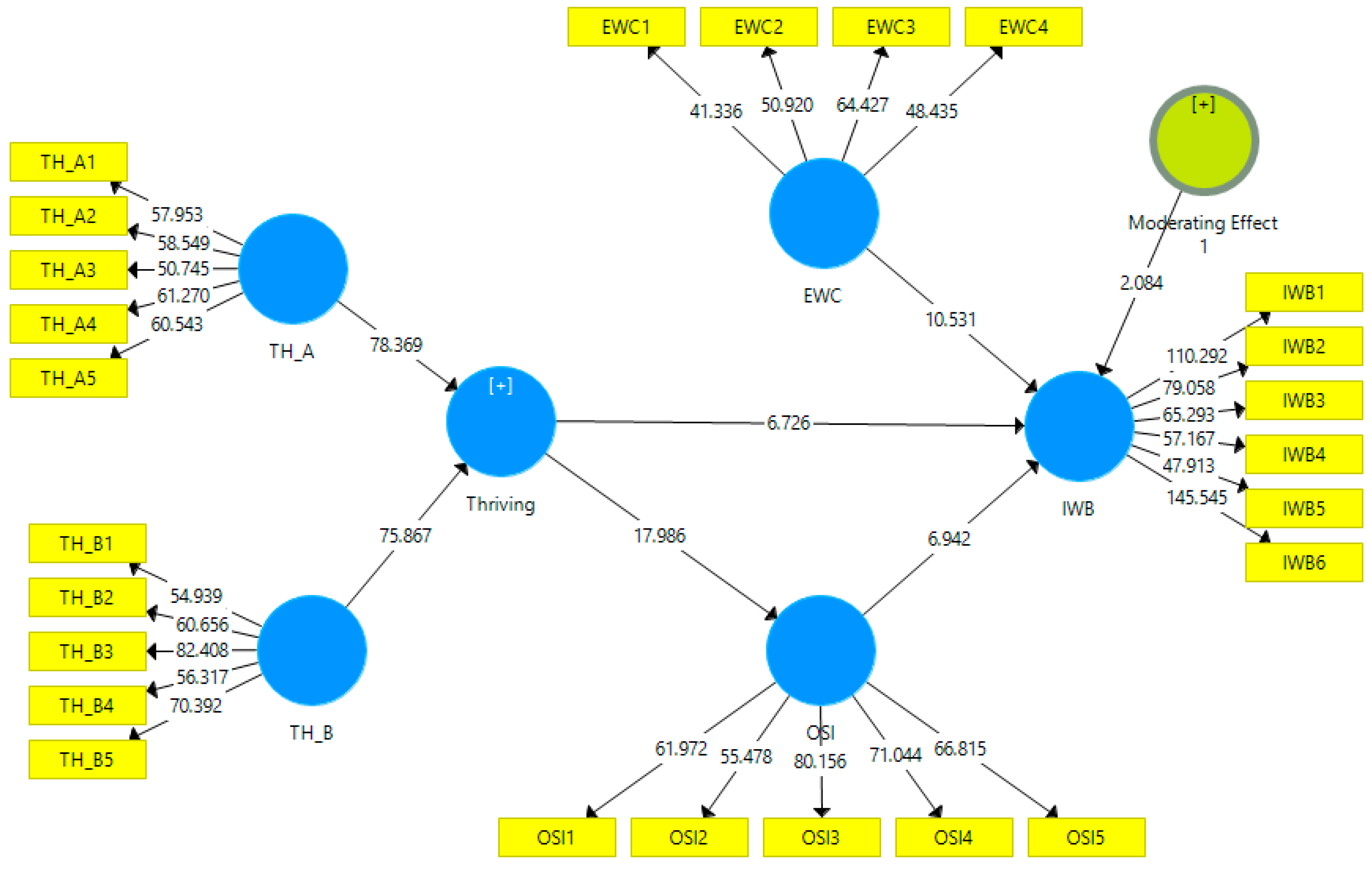Understanding Employee Innovative Behavior and Thriving at Work: A Chinese Perspective
Abstract
1. Introduction
2. Theoretical Background and Hypotheses
2.1. Thriving at Work and Organizational Support for Innovation
2.2. Mediating Role of Organizational Support for Innovation
2.3. Interaction Effect of External Work Contacts
3. Method
3.1. Procedure, Data, Sample
3.2. Measures
3.2.1. Innovative Work Behavior
3.2.2. Thriving at Work
3.2.3. Support for Innovation
3.2.4. External Work Contacts
3.2.5. Control Variables
4. Results
4.1. Measurement Model
4.2. Structural Components
5. Discussion
6. Limitations and Directions for Future Research
Managerial Implications and Conclusions
Author Contributions
Acknowledgments
Conflicts of Interest
References
- Amabile, Teresa M., Regina Conti, Heather Coon, Jeffrey Lazenby, and Michael Herron. 1996. Assessing the work environment for creativity. Academy of Management Journal 39: 1154–84. [Google Scholar]
- Bagozzi, Richard P., and Youjae Yi. 1988. On the evaluation of structural equation models. Journal of the Academy of Marketing Science 16: 74–94. [Google Scholar] [CrossRef]
- Bowen, David E., and Cheri Ostroff. 2004. Understanding HRM–firm performance linkages: The role of the “strength” of the HRM system. Academy of Management Review 29: 203–21. [Google Scholar]
- Brislin, Richard W. 1970. Back-translation for cross-cultural research. Journal of Cross-Cultural Psychology 1: 185–216. [Google Scholar] [CrossRef]
- Carmeli, Abraham, and John Schaubroeck. 2007. The influence of leaders’ and other referents’ normative expectations on individual involvement in creative work. The Leadership Quarterly 18: 35–48. [Google Scholar] [CrossRef]
- Carmeli, Abraham, Daphna Brueller, and Jane E. Dutton. 2009. Learning behaviours in the workplace: The role of high-quality interpersonal relationships and psychological safety. Systems Research and Behavioral Science 26: 81–98. [Google Scholar] [CrossRef]
- Carmeli, Abraham, and Gretchen M. Spreitzer. 2009. Trust, connectivity, and thriving: Implications for innovative behaviors at work. The Journal of Creative Behavior 43: 169–91. [Google Scholar] [CrossRef]
- Carr, Jennifer Z., Aaron M. Schmidt, J. Kevin Ford, and Richard P. DeShon. 2003. Climate perceptions matter: A meta-analytic path analysis relating molar climate, cognitive and affective states, and individual level work outcomes. Journal of Applied Psychology 88: 605. [Google Scholar] [CrossRef] [PubMed]
- Chin, Wynne W. 1998. The partial least squares approach to structural equation modeling. Modern Methods for Business Research 295: 295–336. [Google Scholar]
- Chin, Wynne W., Barbara L. Marcolin, and Peter R. Newsted. 2003. A partial least squares latent variable modeling approach for measuring interaction effects: Results from a Monte Carlo simulation study and an electronic-mail emotion/adoption study. Information Systems Research 14: 189–217. [Google Scholar] [CrossRef]
- Cole, Michael S., William S. Schaninger, and Stanley G. Harris. 2002. The workplace social exchange network a multilevel, conceptual examination. Group & Organization Management 27: 142–67. [Google Scholar]
- Cropanzano, Russell, and Marie S. Mitchell. 2005. Social exchange theory: An interdisciplinary review. Journal of Management 31: 874–900. [Google Scholar] [CrossRef]
- Crossan, Mary M., and Marina Apaydin. 2010. A multi-dimensional framework of organizational innovation: A systematic review of the literature. Journal of Management Studies 47: 1154–91. [Google Scholar] [CrossRef]
- De Jong, Jeroen, and Deanne Den Hartog. 2010. Measuring innovative work behaviour. Creativity and Innovation Management 19: 23–36. [Google Scholar] [CrossRef]
- De Jong, Jeroen P. J., and Deanne N. Den Hartog. 2005. Determinanten van innovatief gedrag: een onderzoek onder kenniswerkers in het MKB. Gedrag & Organisatie 18: 235–59. [Google Scholar]
- Deci, Edward L., and Richard M. Ryan. 2000. The “what” and “why” of goal pursuits: Human needs and the self-determination of behavior. Psychological Inquiry 11: 227–68. [Google Scholar] [CrossRef]
- Dutton, Jane E. 2003. Energize Your Workplace: How to Create and Sustain High-Quality Connections at Work. San Francisco: Jossey-Bass. [Google Scholar]
- Falk, R. Frank, and Nancy B. Miller. 1992. A Primer for Soft Modeling. Akron: University of Akron Press, p. 80. [Google Scholar]
- Fornell, Claes, and David F. Larcker. 1981. Evaluating structural equation models with unobservable variables and measurement error. Journal of Marketing Research 18: 39–50. [Google Scholar] [CrossRef]
- Fritz, Charlotte, Chak Fu Lam, and Gretchen M. Spreitzer. 2011. It’s the little things that matter: An examination of knowledge workers’ energy management. The Academy of Management Perspectives 25: 28–39. [Google Scholar]
- Gilson, Lucy L., and Christina E. Shalley. 2004. A little creativity goes a long way: An examination of teams’ engagement in creative processes. Journal of Management 30: 453–70. [Google Scholar] [CrossRef]
- Granovetter, Mark. 1981. The Strength of Weak Ties: A Network Theory Revisited. Sociological Theory 1: 201–33. [Google Scholar] [CrossRef]
- Granovetter, Mark S. 1973. The strength of weak ties. American Journal of Sociology 78: 1360–80. [Google Scholar] [CrossRef]
- Hair, Joseph F., Jr., G. Tomas M. Hult, Christian Ringle, and Marko Sarstedt. 2016. A Primer on Partial Least Squares Structural Equation Modeling (PLS-SEM). Thousand Oaks: SAGE Publications Inc. [Google Scholar]
- Hofstede, Geert H., and Geert Hofstede. 2001. Culture’s Consequences: Comparing Values, Behaviors, Institutions and Organizations across Nations. Thousand Oaks: Sage. [Google Scholar]
- Hülsheger, Ute R., Neil Anderson, and Jesus F. Salgado. 2009. Team-level predictors of innovation at work: A comprehensive meta-analysis spanning three decades of research. Journal of Applied Psychology 94: 1128. [Google Scholar] [CrossRef] [PubMed]
- Hunter, Samuel T., Katrina E. Bedell, and Michael D. Mumford. 2007. Climate for creativity: A quantitative review. Creativity Research Journal 19: 69–90. [Google Scholar] [CrossRef]
- Janssen, Onne. 2004. How fairness perceptions make innovative behavior more or less stressful. Journal of Organizational Behavior 25: 201–15. [Google Scholar] [CrossRef]
- Jokisaari, Markku. 2013. The role of leader-member and social network relations in newcomers’ role performance. Journal of Vocational Behavior 82: 96–104. [Google Scholar] [CrossRef]
- Kanter, Rosabeth Moss. 1988. Three tiers for innovation research. Communication Research 15: 509–23. [Google Scholar] [CrossRef]
- Kark, Ronit, and Abraham Carmeli. 2009. Alive and creating: The mediating role of vitality and aliveness in the relationship between psychological safety and creative work involvement. Journal of Organizational Behavior 30: 785–804. [Google Scholar] [CrossRef]
- Korzilius, Hubert, Joost J. L. E. Bücker, and Sophie Beerlage. 2017. Multiculturalism and innovative work behavior: The mediating role of cultural intelligence. International Journal of Intercultural Relations 56: 13–24. [Google Scholar] [CrossRef]
- Krackhardt, David. 1992. The strength of strong ties: The importance of philos in organizations. Networks and Organizations: Structure, Form, and Action 216: 239. [Google Scholar]
- Lee, Ching-Sung, Yen-Cheng Chen, Pei-Ling Tsui, and Tung-Han Yu. 2014. Examining the relations between open innovation climate and job satisfaction with a PLS path model. Quality & Quantity 48: 1705–22. [Google Scholar]
- Lin, Liang-Hung, and Yu-Ling Ho. 2010. Guanxi and OCB: The Chinese cases. Journal of Business Ethics 96: 285–98. [Google Scholar] [CrossRef]
- Madjar, Nora, Greg R. Oldham, and Michael G. Pratt. 2002. There’s no place like home? The contributions of work and nonwork creativity support to employees’ creative performance. Academy of Management Journal 45: 757–67. [Google Scholar]
- Madrid, Hector P., Malcolm G. Patterson, Kamal S. Birdi, Pedro I. Leiva, and Edgar E. Kausel. 2014. The role of weekly high-activated positive mood, context, and personality in innovative work behavior: A multilevel and interactional model. Journal of Organizational Behavior 35: 234–56. [Google Scholar] [CrossRef]
- Mumford, Michael D., Ginamarie M. Scott, Blaine Gaddis, and Jill M. Strange. 2002. Leading creative people: Orchestrating expertise and relationships. The Leadership Quarterly 13: 705–50. [Google Scholar] [CrossRef]
- Niessen, Cornelia, Sabine Sonnentag, and Friederike Sach. 2012. Thriving at work—A diary study. Journal of Organizational Behavior 33: 468–87. [Google Scholar] [CrossRef]
- Nunnally, J. C., and I. H. Bernstein. 1994. Psychometric Theory, 3rd ed. New York: McGraw-Hill. [Google Scholar]
- Nybakk, Erlend, Pablo Crespell, and Eric Hansen. 2011. Climate for innovation and innovation strategy as drivers for success in the wood industry: Moderation effects of firm size, industry sector, and country of operation. Silva Fennica 45: 415–30. [Google Scholar] [CrossRef]
- Oldham, Greg R., and Anne Cummings. 1996. Employee creativity: Personal and contextual factors at work. Academy of Management Journal 39: 607–34. [Google Scholar]
- Patterson, Malcolm, Peter Warr, and Michael West. 2004. Organizational climate and company productivity: The role of employee affect and employee level. Journal of Occupational and Organizational Psychology 77: 193–216. [Google Scholar] [CrossRef]
- Perry-Smith, Jill E., and Christina E. Shalley. 2003. The social side of creativity: A static and dynamic social network perspective. Academy of Management Review 28: 89–106. [Google Scholar] [CrossRef]
- Podsakoff, Philip M., Scott B. MacKenzie, Jeong-Yeon Lee, and Nathan P. Podsakoff. 2003. Common method biases in behavioral research: A critical review of the literature and recommended remedies. Journal of Applied Psychology 88: 879. [Google Scholar] [CrossRef] [PubMed]
- Porath, C., G Spreitzer, and C. Gibson. 2008. Antecedents and consequences of thriving at work across six organizations. Paper presented at the 2008 Academy of Management Meeting, Anaheim, CA, USA, 8–13 August. [Google Scholar]
- Porath, Christine, Gretchen Spreitzer, Cristina Gibson, and Flannery G. Garnett. 2012. Thriving at work: Toward its measurement, construct validation, and theoretical refinement. Journal of Organizational Behavior 33: 250–75. [Google Scholar] [CrossRef]
- Preacher, Kristopher J., and Andrew F. Hayes. 2008. Asymptotic and resampling strategies for assessing and comparing indirect effects in multiple mediator models. Behavior Research Methods 40: 879–91. [Google Scholar] [CrossRef] [PubMed]
- Prem, Roman, Sandra Ohly, Bettina Kubicek, and Christian Korunka. 2017. Thriving on challenge stressors? Exploring time pressure and learning demands as antecedents of thriving at work. Journal of Organizational Behavior 38: 108–23. [Google Scholar] [CrossRef] [PubMed]
- Ringle, Christian M., Marko Sarstedt, and Detmar Straub. 2012. A critical look at the use of PLS-SEM in MIS Quarterly. MIS Quarterly (MISQ) 36: iii–xiv. [Google Scholar]
- Ryff, Carol D. 1989. Happiness is everything, or is it? Explorations on the meaning of psychological well-being. Journal of Personality and Social Psychology 57: 1069. [Google Scholar] [CrossRef]
- Schoenewolf, Gerald. 1990. Emotional contagion: Behavioral induction in individuals and groups. Modern Psychoanalysis 88: 879. [Google Scholar]
- Scott, Susanne G., and Reginald A. Bruce. 1994. Determinants of innovative behavior: A path model of individual innovation in the workplace. Academy of Management Journal 37: 580–607. [Google Scholar]
- Shanker, Roy, Ramudu Bhanugopan, Beatrice I. J. M. van der Heijden, and Mark Farrell. 2017. Organizational climate for innovation and organizational performance: The mediating effect of innovative work behavior. Journal of Vocational Behavior 100: 67–77. [Google Scholar] [CrossRef]
- Siegel, Saul M., and William F. Kaemmerer. 1978. Measuring the perceived support for innovation in organizations. Journal of Applied Psychology 63: 553. [Google Scholar] [CrossRef]
- Spreitzer, Gretchen, Kathleen Sutcliffe, Jane Dutton, Scott Sonenshein, and Adam M Grant. 2005. A socially embedded model of thriving at work. Organization Science 16: 537–49. [Google Scholar] [CrossRef]
- Spreitzer, Gretchen, Christine L. Porath, and Cristina B. Gibson. 2012. Toward human sustainability: How to enable more thriving at work. Organizational Dynamics 41: 155–62. [Google Scholar] [CrossRef]
- Staw, Barry M., and Robert I. Sutton. 2000. Research in Organizational Behavior. Amsterdam: Elsevier, Oxford: JAI, vol. 22. [Google Scholar]
- Terzi, S., A. Trezzini, and L. Moroni. 2014. A PLS path model to investigate the relations between institutions and human development. Quality & Quantity 48: 1271–90. [Google Scholar] [CrossRef]
- Van de Ven, Andrew H. 1986. Central problems in the management of innovation. Management Science 32: 590–607. [Google Scholar] [CrossRef]
- Wallace, J. Craig, Marcus M. Butts, Paul D. Johnson, Flannery G. Stevens, and Mickey B. Smith. 2016. A multilevel model of employee innovation understanding the effects of regulatory focus, thriving, and employee involvement climate. Journal of Management 42: 982–1004. [Google Scholar] [CrossRef]
- Walumbwa, Fred O., Michael K. Muchiri, Everlyne Misati, Cindy Wu, and Meiliani Meiliani. 2018. Inspired to perform: A multilevel investigation of antecedents and consequences of thriving at work. Journal of Organizational Behavior 39: 249–61. [Google Scholar] [CrossRef]
- Wang, Xiao-Hua Frank, Yulin Fang, Israr Qureshi, and Onne Janssen. 2015. Understanding employee innovative behavior: Integrating the social network and leader-member exchange perspectives. Journal of Organizational Behavior 36: 403–20. [Google Scholar] [CrossRef]
- Woodman, Richard W., John E. Sawyer, and Ricky W. Griffin. 1993. Toward a theory of organizational creativity. Academy of Management Review 18: 293–321. [Google Scholar] [CrossRef]
- Yu, Ming-Chuan, Qiang Mai, Sang-Bing Tsai, and Yi Dai. 2018. An Empirical Study on the Organizational Trust, Employee-Organization Relationship and Innovative Behavior from the Integrated Perspective of Social Exchange and Organizational Sustainability. Sustainability 10: 864. [Google Scholar] [CrossRef]



| Frequency | % | Frequency | % | ||
|---|---|---|---|---|---|
| Age (in years) | Management | ||||
| 20–25 | 83 | 20.6 | Top | 67 | 16.7 |
| 26–30 | 110 | 27.4 | Middle | 119 | 29.6 |
| 31–41 | 93 | 23.1 | Low | 216 | 53.7 |
| 41–49 | 65 | 16.2 | Education | ||
| 50 and above | 51 | 12.7 | Middle school | 84 | 20.9 |
| Gender | Graduation | 217 | 54.0 | ||
| Male | 286 | 71.1 | Post-graduation | 78 | 19.4 |
| Female | 116 | 28.9 | Ph.D. | 23 | 5.7 |
| Experience (in years) | |||||
| 0–3 | 107 | 26.6 | |||
| 4–9 | 172 | 42.8 | |||
| 10 and above | 123 | 30.6 |
| M | SD | Thriv | OS | IWB | EWC | |
|---|---|---|---|---|---|---|
| Thriving at work (Thriv) | 3.398 | 0.888 | 1.000 | |||
| Organizational support for innovation (OSI) | 3.101 | 0.969 | 0.602 ** | 1.000 | ||
| Innovative work behavior (IWB) | 3.318 | 1.063 | 0.538 ** | 0.586 ** | 1.000 | |
| External work contacts (EWC) | 3.640 | 0.840 | 0.184 ** | 0.247 ** | 0.554 ** | 1.000 |
| AVE | CR | Cronbach’s Alpha | Thriv | OS | IWB | EWC | |
|---|---|---|---|---|---|---|---|
| Thriving at work (Thriv) | 0.658 | 0.951 | 0.942 | 0.811 | |||
| Organizational support for innovation (OS) | 0.728 | 0.930 | 0.907 | 0.602 | 0.853 | ||
| Innovative work behavior (IWB) | 0.756 | 0.949 | 0.935 | 0.538 | 0.586 | 0.870 | |
| External work contacts (EWC) | 0.704 | 0.905 | 0.9860 | 0.184 | 0.247 | 0.554 | 0.839 |
| Path | Path c Coefficients | Mean | SD | CI (2.5–97.5)% | ||
|---|---|---|---|---|---|---|
| Thriving -> OSI | 0.6022 | 0.6034 | 0.0335 | 17.9856 | 0.0000 | (0.5322, 0.6607) |
| Thriving -> IWB | 0.2636 | 0.2638 | 0.0392 | 6.7261 | 0.0000 | (0.1809, 0.3331) |
| OSI -> IWB | 0.3073 | 0.3041 | 0.0443 | 6.9418 | 0.0000 | (0.2169, 0.3933) |
| EWC -> IWB | 0.4127 | 0.4150 | 0.0392 | 10.5312 | 0.0000 | (0.3365, 0.4945) |
| Thriving -> OSI -> IWB | 0.1851 | 0.1836 | 0.0291 | 6.3591 | 0.0000 | (0.1320, 0.2391) |
| Moderator -> IWB | 0.0725 | 0.0782 | 0.0348 | 2.0845 | 0.0376 | (0.0104, 0.1500) |
© 2018 by the authors. Licensee MDPI, Basel, Switzerland. This article is an open access article distributed under the terms and conditions of the Creative Commons Attribution (CC BY) license (http://creativecommons.org/licenses/by/4.0/).
Share and Cite
Riaz, S.; Xu, Y.; Hussain, S. Understanding Employee Innovative Behavior and Thriving at Work: A Chinese Perspective. Adm. Sci. 2018, 8, 46. https://doi.org/10.3390/admsci8030046
Riaz S, Xu Y, Hussain S. Understanding Employee Innovative Behavior and Thriving at Work: A Chinese Perspective. Administrative Sciences. 2018; 8(3):46. https://doi.org/10.3390/admsci8030046
Chicago/Turabian StyleRiaz, Sidra, Yusen Xu, and Shahid Hussain. 2018. "Understanding Employee Innovative Behavior and Thriving at Work: A Chinese Perspective" Administrative Sciences 8, no. 3: 46. https://doi.org/10.3390/admsci8030046
APA StyleRiaz, S., Xu, Y., & Hussain, S. (2018). Understanding Employee Innovative Behavior and Thriving at Work: A Chinese Perspective. Administrative Sciences, 8(3), 46. https://doi.org/10.3390/admsci8030046





